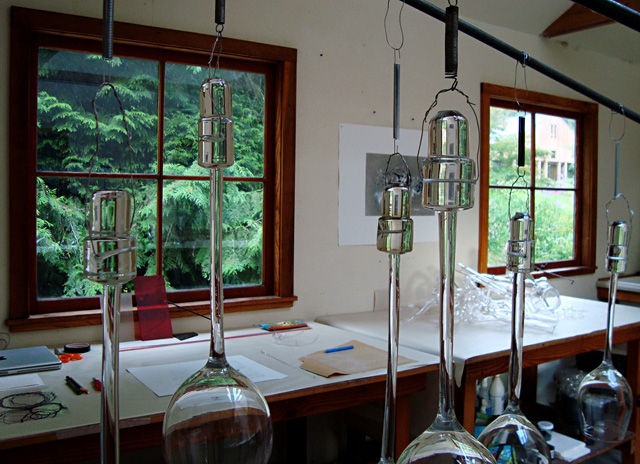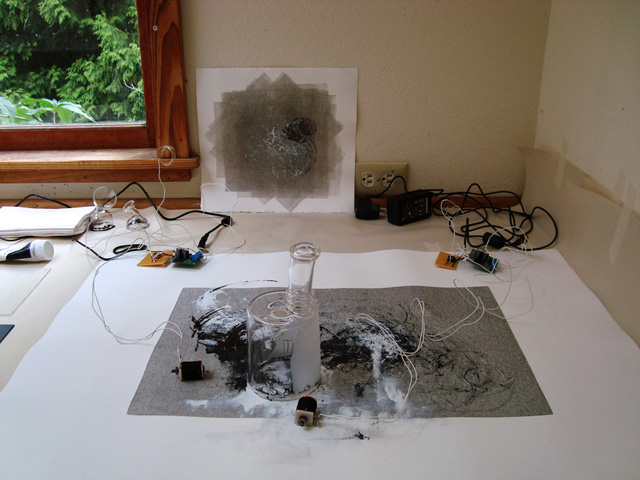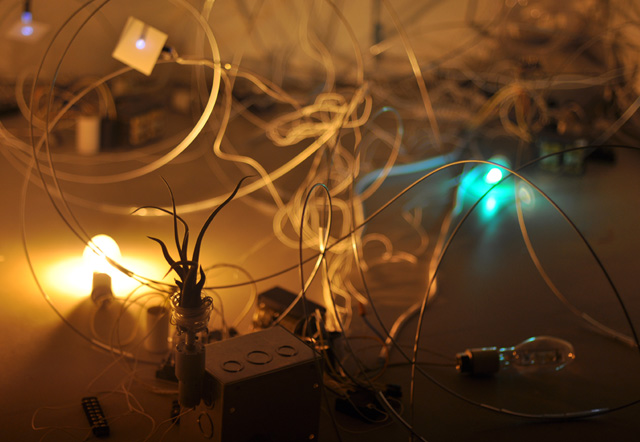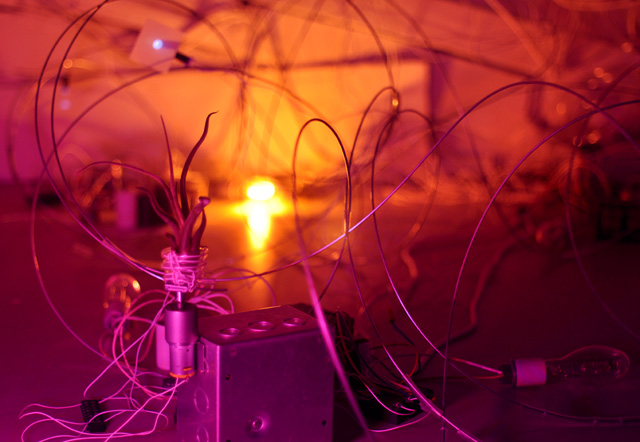our electro-magnet setup in sunlight on a cloudy, winter day. we made a live performance incorporating this work and including some of our glass objects called ballade (below). here is a link to ballade and our other sound recordings on soundcloud.
Author: james and lili
ballade
live performance with handmade glass objects and electro-magnets. the electro-magnet setup appears on its own in ballade, the video and sound piece above, and with our other works on vimeo here.
pilchuck glass school residency documentation


click here for the complete set on Flickr
During our residency at Pilchuck Glass School, we expanded on work started at the Museum of Glass and we developed a series of new works involving sound making objects, printmaking and drawing. We gave two performances during our residency, and some of our printmaking was exhibited during November 2014 at the Pilchuck Glass School Exhibition Space. Additional documentation of our performances and print process are linked below.
Our sound work with glass involves the creation of shapes that can be bowed or struck to produce fundamental pitches and harmonics so that one instrument can sound more than one pitch. Working carefully with our expert gaffers, Manny Krakowski and Netty Blair, we were able to make several variations of vessel shapes that each produced a complex spectrum of tones. We were also able to develop methods of linking two or more objects on a rocking base so that two objects could be played simultaneously by one player and variations on timbre and attack through bowing, striking, rocking were possible.
For our performances we grouped objects in terms of their tunings and timbres making tuning changes (by reshaping, or filling vessels with water) where necessary to create a specific temperament. Once we created a temperament we improvised extensively with it and developed compositions for it. Our compositions are a mix of rehearsed sections/gestures connected by improvisation. While we usually decide how to start and end, the pieces are largely determined during the performance.
In both our sound and print work we used electro-magnet/neodymium magnet setups where the magnets moved in response to changes in the polarities of our electro-magnets that were triggered by fluctuations in the EMF of the space where they were.
As sound, the clinking/tapping of the magnets against glass added a percussive, chaotic element to our compositions; something that fueled our improvisations as the magnets never behaved the same way in each performance.
For the prints, we used the same set of circuitry, vessels and magnets, but as mark making elements. We set the magnets up on inked plates and let them roll until they were covered in ink and had left marks on the plates. We then made several prints with the plates, and then placed the electro-magnet setup on the prints’ surface in the same configuration and let the neodymium magnets deposit the ink they had previously gathered. Freshly inked magnets were also added in the process. As with the sound pieces, the electro-magnet’s polarity oscillates in response to changes in EMF around them.
Our drawings incorporate variations on the shapes of the goblet and the vessel, primary glassblowing forms that suggested to us the physiology of the inner ear. The drawings functioned as non-dimensional starting points for the development of our sculptural and sound making objects.
Our time at Pilchuck was special and we are grateful to the long list of wonderful people who made our experience so memorable including Tina Aufiero, Rebecca Arday, Jim Baker, Ben Wright, our gaffers Manny Krakowski and Netty Blair, our assistants Keunae Song and Anna Masowsky, Alex Gibson in the printshop, Rebekah Birkan, who constructed the amazing frame for the goblets from found metal in the Pilchuck metal shop and Zach Lorenzetti who made music with us and assisted behind the wheel!
electro-magnet print process
This is documentation of our electro-magnet/neodymium ball magnet setup that we use in our sound performances re-cast as a mark making element for generating a series of prints at the Pilchuck Glass School print studio.
We set the magnets up on inked plates and let them roll until they were covered in ink and had left marks on the plates. We then made several prints with the plates, and then placed the electro-magnet setup on the prints’ surface, in the same configuration, and let the neodymium magnets deposit the ink they had previously gathered. Freshly inked magnets were also added in the process.
The magnetic field oscillates in response to changes in EMF.
Our work will be exhibited in Seattle during November at the Pilchuck Glass School Exhibition Space.
temperament series
temperament series are new live recordings of performances with glass instruments and electromagnets developed during our residencies at the Museum of Glass and Pilchuck Glass School.
images are on flickr.

@ Pilchuck Glass School – Artists in Residence, Summer 2014
museum of glass residency



For our Museum of Glass residency our preparation included a material investigation of glass that resulted in an interest in its sonic and sculptural properties. We worked with combining fundamental glass forms (goblets and vessels) and electro-magnets (as a way of making sound), and making those forms resonate by striking and bowing them. A concept of hybridization, experimentation, improvisation and performance began to emerge.
We arrived at the museum with non-dimensional drawings based on the physiology of the inner ear that functioned as starting points for the development of sculptural and sound making objects that we developed and made with the hot shop team.
Informed by our research and recent developments in our collaborative practice we took the opportunity to engage the hot shop as studio space, installation space and performance space.
The results of our process included sculptural objects (two of which are now part of the museum’s permanent collection), drawings, an installation and sound performance.
The sculptural forms we made also functioned as acoustic resonators in our sound performance.
for the flickr set click here.
38 hours to spring
the music is a variation on the song of seikilos.
à la vitesse de ton souffle
more details for the work are on the vimeo page.
Influenced by our time walking in and around Paris, La Générale and the jardins de Versailles, à la vitesse de ton souffle is an installation in the form of a sequence of compositions and spaces made of sound, light, objects and movement, activated by visitors walking through the gallery at the speed of their own breathing. Each composition oscillates and slips between various binaries: formal and semiotic, interior and exterior, found and placed, organic and artificial, operand and operator. à la vitesse de ton souffle is a perambulation in a twilight heterotopia of green and pink noise.
Influencés par le temps passé à nous promener dans et autour de Paris, La Générale et les jardins de Versailles, à la vitesse de ton souffle est une installation qui prend forme dans l’ordre des compositions et des espaces créés par le son, la lumière, les objets et les mouvements, activés par les visiteurs qui se déplacent dans l’espace à la vitesse de leur respiration. Chaque assemblage oscille et glisse entre diverses dualités : formel et sémiotique, intérieur et extérieur, trouvé et placé, organique et artificiel, opérant et opérateur. à la vitesse de ton souffle est une pérambulation dans un crépuscule hétérotopique d’un bruit vert et rose.
au concert printemps flottant
au concert printemps flottant was shown at the palais de tokyo as part of concert hall, a large collaborative work included in nouvelle vagues.
au concert printemps flottant is a kinetic installation composed of organic and industrial materials, including a live tillandsia medusa, a custom LED grow light, a motor, and commercial gas vapor street lights, among other materials. a micro-controller regulates movement and changes in lighting intended to both sustain the tillandsia and reveal a sequence of 26 short variations in movement and light over 11 minutes. au concert printemps flottant was built and programmed on-site during the installation period for nouvelle vagues’ concert hall and was influenced by, and references, the themes of music, play and integration at the heart of this exhibit.
the materials include: tillandsia caput-medusa, electronics, plastic tubing, metal springs, custom electric light, vellum, wood, paint.
the dimensions of the work are approximately 10’x20’x15′.
for the flickr set click here.
quine
quine was shown at our solo show at die Botschaft, and is named for logician/mathematician Willard Van Orman Quine. a quine is a computer program that takes no input and produces a copy of its own source code as its only output. our quine was made with the shadows of leaves and branches, and light (sunlight and streetlight) that played across the gallery wall behind it. the changes in light on quine’s surface are intended to evoke an active slippage where the edges of the work expand and contract with the changing ambient light of its environment. the piece is solar powered and composed of motors, circuitry, wire, tape, vellum, leaves, and LEDs.
still images here

